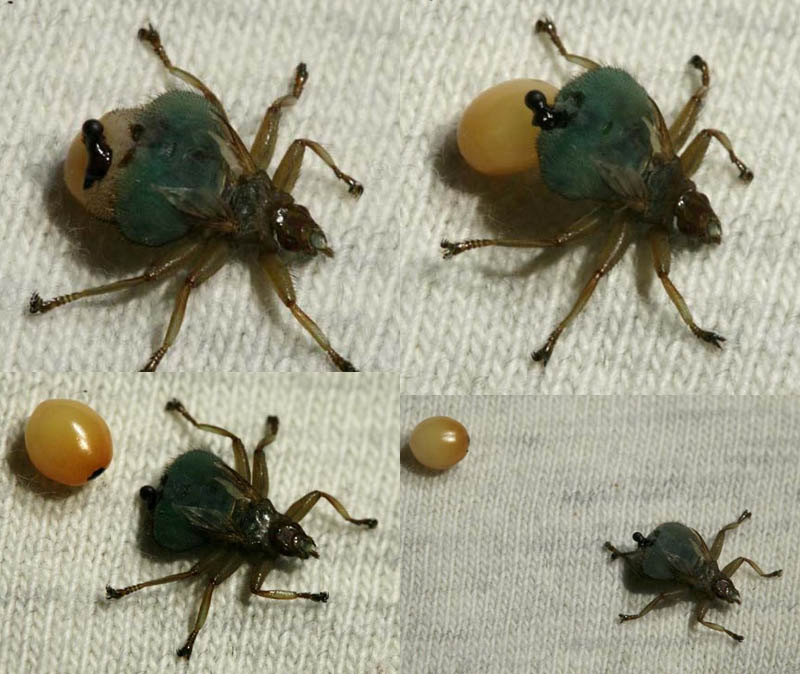Diptera.info :: Identification queries :: Diptera (adults)
|
Hippoboscidae laying egg
|
|
| JariF |
Posted on 24-08-2008 07:59
|
|
Member Location: Helsinki, Finland Posts: 2072 Joined: 20.01.06 |
Hi, my very good friend Pasi J?rgens is workin in our zoo. During the year several wounded specimens are brought there to have some help. Birds have been flying to windows etc. He has been rearing Common Swifts (Apus apus) over ten years and every year around 10-15 % of the birds are carrying this fly. This time the behaviour of the fly was differend and made Pasi to take his camera for pictures. The fly must have been in the end of it's life cycle, because it layed an egg  . This was something that made us wonder and ask if someone knows more. There is only one egg, or is it egg at all ? I believe the fly is Crataerina pallida but what came out from it's abdomen ? Pupae, eggsack, just one egg, some parasite .... The pistures were taken yesterday August 23. 2008 here in Helsinki, Finland. . This was something that made us wonder and ask if someone knows more. There is only one egg, or is it egg at all ? I believe the fly is Crataerina pallida but what came out from it's abdomen ? Pupae, eggsack, just one egg, some parasite .... The pistures were taken yesterday August 23. 2008 here in Helsinki, Finland.Jari JariF attached the following image:  [95.03Kb] |
|
|
|
| pierred |
Posted on 24-08-2008 08:33
|
|
Member Location: Paris (France) Posts: 1484 Joined: 21.04.05 |
Hello, Hippoboscidae are called pupipar, because they don't lay eggs, but pupae, directly. In other words, the eggs becomes a pupa directly in the body of the mother. I suppose that this is the meaning of this sequence. Pierre Duhem |
|
|
|
| JariF |
Posted on 24-08-2008 15:33
|
|
Member Location: Helsinki, Finland Posts: 2072 Joined: 20.01.06 |
Hi, thank You so much. This is interesting. Does it mean, that the adult fly will have only one egg/larva/pupae at the time ? How many they will produce all and all ? I mean, that normally flies have tens or hundreds of eggs and larvae. Hippoboscidae must live very long time to produce enough descendants to survive. Jari |
|
|
|
| Paul Beuk |
Posted on 24-08-2008 19:15
|
|
Super Administrator Location: Netherlands Posts: 19403 Joined: 11.05.04 |
The eggs hatch inside the female abdomen (one at the time  ) and the larva is fed it the female abdomen. As soon as the larva is full-grown it will be deposited in a proper place (as 'pre-pupa' ) and the larva is fed it the female abdomen. As soon as the larva is full-grown it will be deposited in a proper place (as 'pre-pupa' and pupate immediately. Then the next eggs will hatch and the cycle starts again. and pupate immediately. Then the next eggs will hatch and the cycle starts again.It may seem laborious and little productive, but acually larval survival may be higher in Hippoboscidae than in many 'regular' species, where there can occur high mortality aong eggs and larvae because of predators, parsites and parasitoids, let alone infections of fungi. Remember, you only need two reproducing descendants (preferably a male and a female  ) to keep the species surviving. ) to keep the species surviving.
Paul - - - - Paul Beuk on https://diptera.info |
| Kahis |
Posted on 24-08-2008 19:29
|
|
Member Location: Helsinki, Finland Posts: 1999 Joined: 02.09.04 |
Ooof, that must hurt  The new (pre)pupa is still translucent in this pictures. You can see the larva/pupa proper inside. Kahis |
| JariF |
Posted on 25-08-2008 06:05
|
|
Member Location: Helsinki, Finland Posts: 2072 Joined: 20.01.06 |
Thank You  Jari |
|
|
|
| mswalker |
Posted on 24-04-2015 01:51
|
|
Member Location: Posts: 3 Joined: 21.04.15 |
JariF- I am a science writer working on an article on Hippoboscids for Entomolgy Today, a blog published by the Entomological Society of America. The photos you posted above are the best I have seen. If you are interested in allowing The Entomologiy Today blog to publish your photo please contact me: mbswett@gmail.com You will get credit for the photo of course. Even if you don't give permission to us the photo, I want to thank you for this disgusting and fascinating image! |
|
|
|
| Jump to Forum: |













